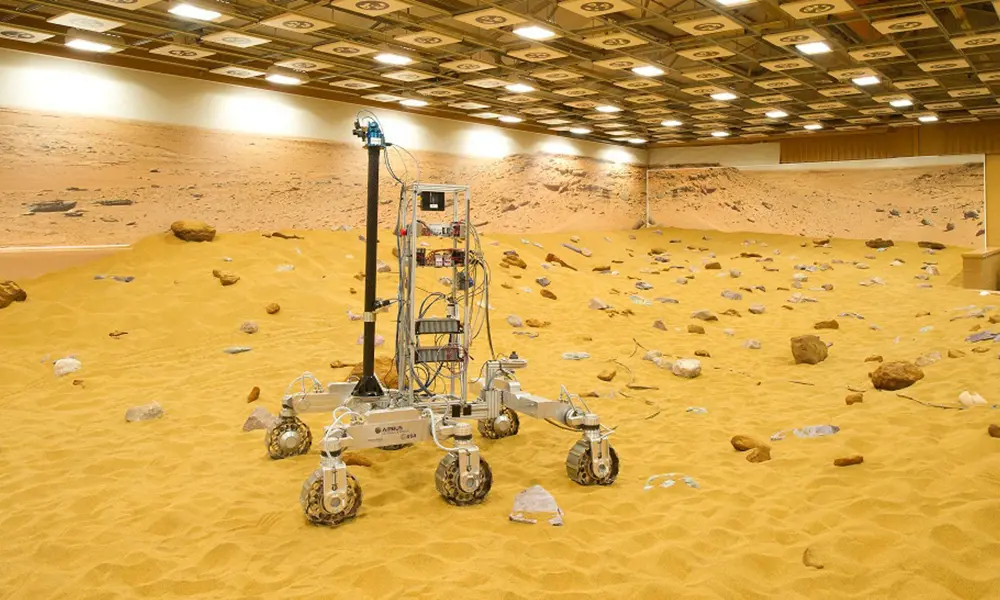
Finding life on Mars
3.8 billion years ago, the planet Mars was not unlike Earth. Wrapped in a thick atmosphere, it had large quantities of liquid water on its surface and a strong magnetic field protecting it from cosmic radiation. But then something significant happened: the magnetic field disappeared and the atmosphere evaporated into space. Mars turned into the ‘red planet’ – dry, arid and hostile.
That significant ‘something’ happened at about the same time that first life was evolving on Earth, leading scientists to believe that, just like Earth, pre-climate-change Mars might have harboured primitive forms of life. “The conditions on Mars then were very similar to the conditions on Earth then,” said Professor Andrew Coates, of the Department of Space and Climate Physics of University College London (UCL). “We think that life could have started then because it had the same basic substances there as Earth had.”
UCL’s Mullard Space Science Laboratory is the UK’s oldest and largest university-based space technology and research facility. Over its more than 50 years of existence, the laboratory has contributed to missions including the Jupiter-exploring spacecraft Cassini, a collaboration between NASA and the European Space Agency (ESA), and ESA’s flagship space telescopes Herschel, XMM-Newton and Solar Orbiter.
A dream that started with the Beagle 2 Martian lander
For Professor Coates, the dream of helping to find life on Mars started in the 1990s when a team of British scientists developed the idea of the Beagle 2 Martian lander. The mission infamously failed upon landing on Christmas Day 2003, only to be discovered on the surface of Mars by a NASA orbiter 12 years later.
The stereo camera aboard Beagle 2, which Professor Coates and his team had developed, didn’t get its chance to work. It did however provide the basis for PanCam (Panoramic Camera), an instrument dubbed the scientific eyes of the European ExoMars rover.
The rover, a pan-European project that was assembled over a period of 18 months by Airbus UK in Stevenage, is expected to launch in July 2020. It is the first rover designed specifically to find life on Mars, and has been named ‘Rosalind Franklin’ after the UK chemist and X-ray crystallographer who contributed to unravelling the double helix structure of our DNA. PanCam is one of nine instruments on board the rover that will work together to make that happen.
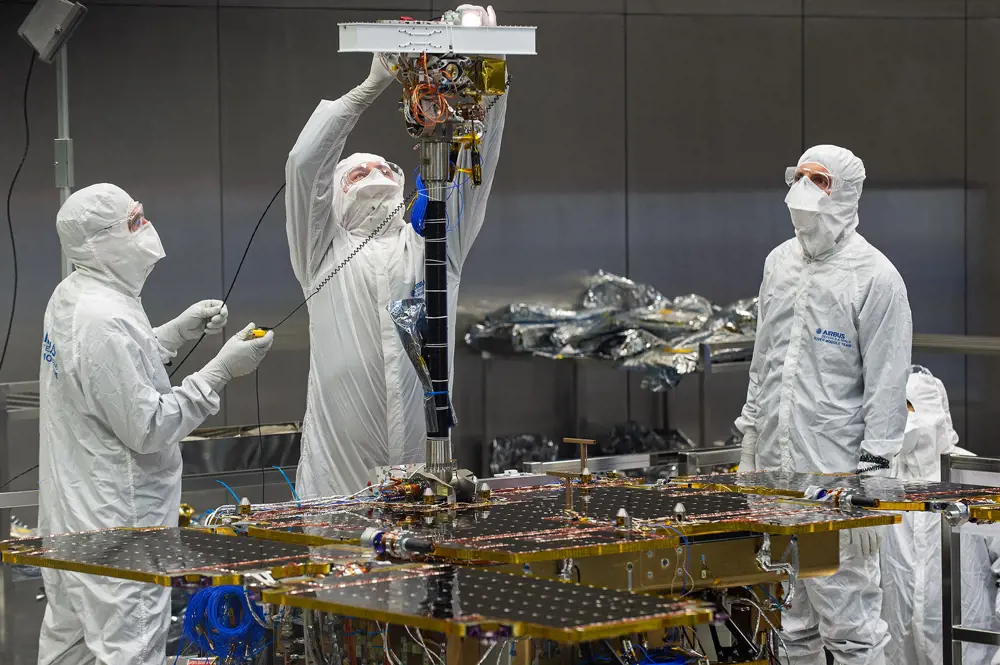
The PanCam being tested on the ExoMars rover in Airbus’ cleanroom in Stevenage © Airbus, M Alexander
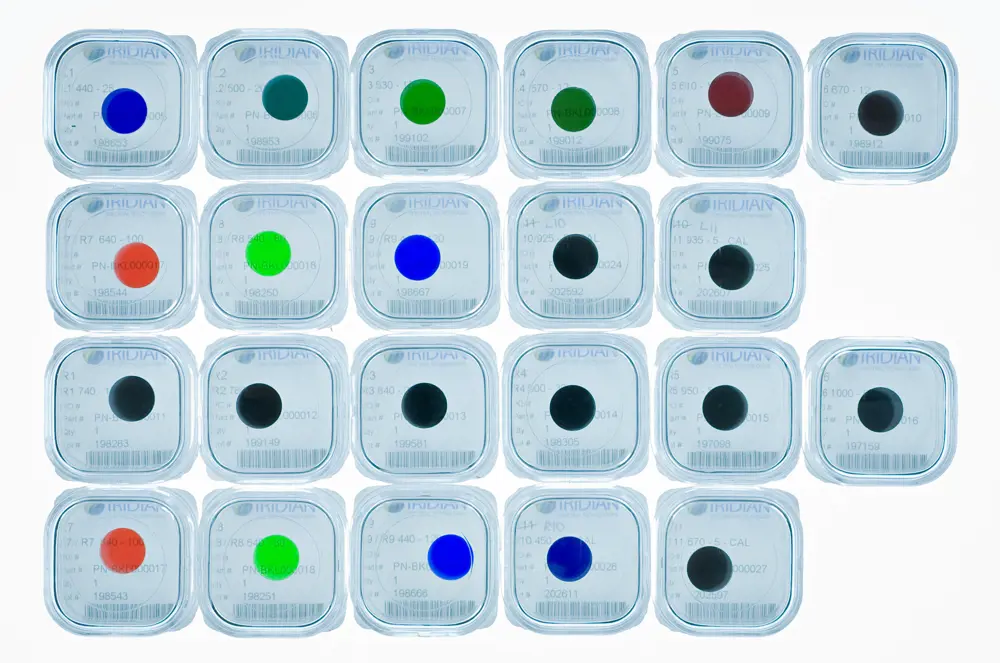
These are the filters that the ExoMars rover will use to view Mars in visible and near infrared wavelengths. They are pictured here in their individual transport cases, before they were installed in the filter wheels of the Panoramic Camera © UCL/MSSL, M. de la Nougerede
Drilling below the surface for life
PanCam, the only instrument led by a British team, will be the first to deploy once the rover lands in the Oxia Planum area, near the equatorial belt of Mars. While still sitting on top of the Russian-made Kazachok landing platform, the rover will unfold its solar panels. Then, a two-metre mast, with PanCam, NavCam (a set of navigation cameras) and ISEM (an infrared spectrometer) mounted to the top of it, will be erected.
Spinning around on its pan and tilt head, PanCam will take its first panoramic image of Mars, which will be beamed to Earth for the ground control team to analyse and decide which of the landing platform’s two ramps to use to commence the ground-breaking mission. “PanCam is probably the main instrument of what we call the ‘context instruments’ on the ExoMars rover,” said Coates. “It will provide us with the geological and atmospheric context. It will show us the landscape and help us see where there are potentially interesting rocks or features to explore and look for signs of life.”
PanCam consists of two black and white wide-angle one-megapixel cameras sitting 50 centimetres apart, and a high-resolution camera for detailed inspection of rocks. Each of the wide-angle cameras has a wheel with 11 coloured filters in front of it, which will enable the researchers to image the surrounding surface at different wavelengths and build up the spectra in which the rocks reflect light. “The filters are specifically dyed to be very good at looking for water-rich minerals like clays because that’s where signs of life potentially could be,” said Professor Coates. “It’s the best ever camera to be sent to Mars with this purpose.”
The filters are specifically dyed to be very good at looking for water-rich minerals like clays because that’s where signs of life potentially could be
The scientists can send only 10 images a day to Earth. These images will be used to decide where to direct the rover next. In addition to PanCam and the infrared spectrometer, the rover carries seven other instruments. The close-up imager for detailed inspection of rocks is mounted next to the drill. The ground-penetrating radar and neutron spectrometer, both located in the rear, will provide information about the geology under the surface and the content of water in the ground. The Ma_MISS multispectral imager that will be located in the tip of the rover’s two-metre drill will capture images as the rover obtains its sample. This two-metre drill is unique to the Rosalind Franklin rover. Its ability to drill up to two metres below the surface enables it to search for traces of life below the top layer of Mars, which is now a harsh place for life to exist due to cold temperatures and the presence of ultraviolet and cosmic radiation. Drilling to a greater depth than any of the previous rover missions will allow soil samples to be retrieved and analysed from an area where life might have been able to survive.
Inside the rover’s analytical drawer are three instruments that will analyse the sample and look for signs of life – the MicrOmega visible and infrared imaging spectrometer for mineralogy studies; the RLS Raman Spectrometer for identification of organic pigments; and the MOMA organic molecule analyser that will look for signs of past and present life.
Autonomous driving on Mars
PanCam will also assist the two navigation cameras in generating input for the rover’s autonomous driving system.
Navigation was one of the biggest challenges the consortium of engineers working on building the rover for ESA had to solve. Having learned valuable lessons from their American colleagues operating NASA’s rovers, the engineers decided to give the Rosalind Franklin an unprecedented level of autonomy. Unlike the American rovers, the European rover does not have a direct link to Earth. It sends and receives data via the ExoMars Trace Gas Orbiter, which reached Martian orbit in 2016.
“We didn’t want to effectively drive the rover like a remote-controlled car from Earth, which is either really inefficient or really dangerous because the time delay can be as much as 20 minutes in the worst case in each way,” said Paul Meacham, Lead Systems Engineer on the ExoMars Rover Vehicle Project at Airbus Defence and Space. “We built a system that allows the rover to drive itself, which is more advanced than that in the American rovers.”
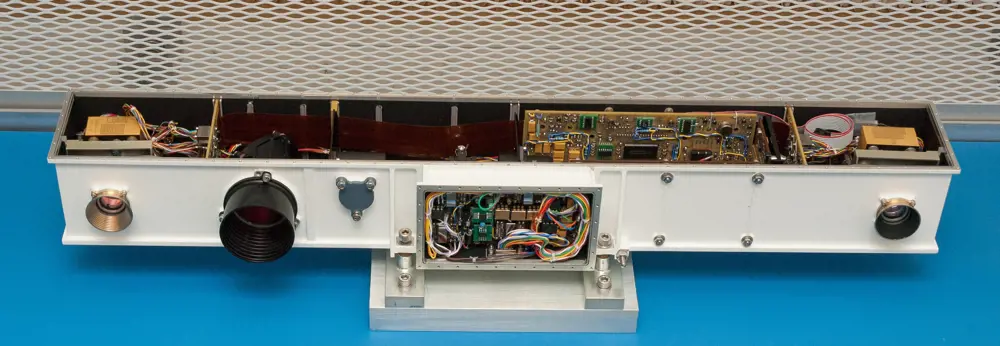
The PanCam engineering model in a clean bench, showing the fully integrated cameras and electronics © UCL/MSSL 2018, M. de la Nougerede
To be able to drive autonomously, the rover needs to be able to perceive the surrounding terrain in 3D. This is enabled by a set of two navigation cameras located on the optical bench on the mast. The navcams acquire black and white images every two metres of the rover’s journey and just like the PanCam cameras, are relatively low resolution.
Meacham explains that when sending technology to space, engineers are working with processing capabilities equal to what was commercially available on the ground about 10 years ago. The process of space-qualification is costly and time-consuming and so cutting-edge science and engineering does not always have the most cutting-edge computing capabilities at its disposal.
“That’s why we see in black and white rather than in colour because it’s faster to process,” said Meacham. “But the critical bit is that the cameras are very carefully aligned with respect to each other, so you can take the image from the right camera and the left camera and combine them together to produce a 3D picture.” That enables the software in the rover to judge the rover’s position with respect to the objects in the image. The rover gradually builds up a navigation map of the environment replacing low quality data with higher quality data, as it gets closer to its targets.
The engineers trained the software on thousands of scenarios; driving in a computer-generated Martian terrain and simulating various situations the robot might find itself in
The engineers trained the software on thousands of scenarios; driving in a computer-generated Martian terrain and simulating various situations the robot might find itself in. “The digital model allows us to run these scenarios extremely quickly,” said Meacham. “We can drive our rover over all sorts of situations, over hundreds of metres, we can crash it and then develop algorithms so that the rover handles all sorts of situations that it might encounter on Mars.”
An additional two cameras, located at the base of the mast, take images as the rover travels to measure where it is located relative to the selected path. The software controlling this part of the autonomous driving process is, according to Meacham, similar to the Hawk-Eye system used in sports such as tennis, which tracks the trajectory of a ball and displays its most statistically likely path. “It monitors a thousand points on the terrain in front of the rover and as the rover moves it sees where those points go and from that it can work out both its position and its attitude – pitch and roll,” Meacham said.
After the software had proven its abilities in the digital models, the engineers verified it using ExoMars rover prototypes in the Mars yard – a giant sandpit mimicking the slopes and rock composition on Mars, which was built at the Airbus UK site in Stevenage.
Designing the rover for the freezing cold
The Rosalind Franklin rover gets power from its solar array. The solar panels also charge a lithium-ion battery that powers the rover’s critical systems once the Sun goes down. Martian days, known as sols, are 39 minutes and 35 seconds longer than Earth days, and there are 668 sols in a Martian year.
Especially in winter, the temperature at night can drop as low as –130°C. Daytime temperature in Oxia Planum could reach about 10°C. The extreme temperature difference the rover will be subject to can cause potential problems for all of its systems.
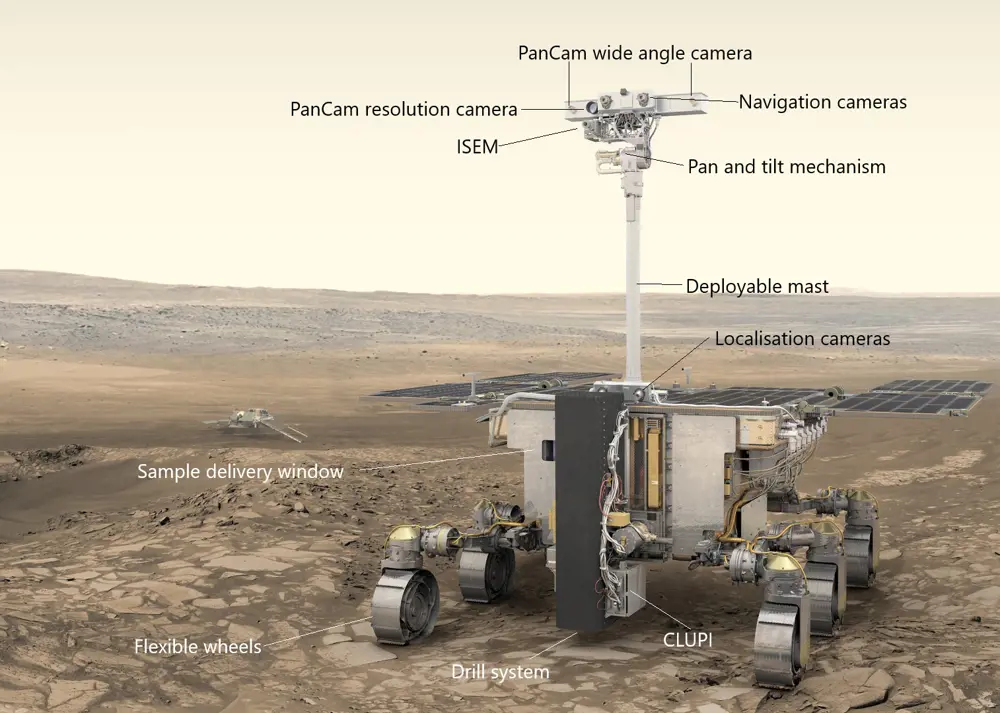
These are the filters that the ExoMars rover will use to view Mars in visible and near infrared wavelengths. They are pictured here in their individual transport cases, before they were installed in the filter wheels of the Panoramic Camera © UCL/MSSL, M. de la Nougerede
“Normally, satellite systems are only qualified to -50°C,” said Tom Hunt, PanCam Systems Engineer at the Mullard Space Science Laboratory. “In orbit, where we send most of our technology, the temperature is relatively stable. But with Mars it’s very different. We had to plan and test specifically for that.” Mars has a very thin atmosphere that doesn’t keep the planet warm at night. On the other hand, the presence of an atmosphere causes the spacecraft to lose heat through convection, as opposed to radiation-only heat loss, which happens in orbit.
For the main body of the rover the Airbus engineers designed a solution that uses the same principle as double-glazed windows to prevent the convective heat loss. “The main structure of the rover, which we call the bath tub, has a layer of cold gas trapped between the inner skin of the bathtub and a kapton baffle” said Airbus’ Meacham. “We have also coated the structure in gold to stop heat loss by radiation.”
But overheating during the day might be a problem too, Meacham said. With the rover’s motors and multiple instruments possibly running at the same time, the engineers had to think about how to remove the excess heat if needed. “We have a loop heat pipe, which takes the heat from inside the rover and transports it to a radiator, which has a white surface and dissipates the heat when we get too hot,” said Meacham. “The loop heat pipe is filled with liquid that will evaporate on the hot end. The vapour travels along the pipe, condenses on the cold end and releases the heat.”
The rover can turn the system on and off automatically, reacting immediately when the temperature changes. The PanCam engineers had to design their own temperature control mechanisms since the mast doesn’t fold back down after its initial deployment, leaving the optical bench completely unprotected. Due to the massive temperature changes, the 56-centimetre aluminium structure of the optical bench holding the two wide-angle cameras and the high-resolution camera could shrink by 2 millimetres. The shrinking and expansion of the material could easily damage the cameras’ lenses, the filters as well as the electronics inside.
In orbit, where we send most of our technology, the temperature is relatively stable. But with Mars it’s very different. We had to plan and test specifically for that
“Interfaces within the box have to be all from the same material,” said Hunt. “If we need to use components that are from a different material, such as the optics, we have to match the thermal expansion or make mechanical thermal compensation devices so that the materials can be compliant to the movement due to the temperature.” Both of the wide-angle cameras, which had been developed by Thales Alenia Switzerland, as well as the high-resolution camera developed by the German Aerospace Centre, had to be thoroughly tested, together with all the electronics, circuit boards and interfaces.
The UCL team ran an extensive test campaign, using a refrigeration unit with liquid nitrogen to cool down the temperature of the device’s sub-systems 320 times down to –130°C and warming it back up to +50°C within a few hours. The testing followed an accelerated method, which meant the cycle was much shorter than a Martian day would be, with the device only staying at the lowest temperature for 15 minutes. After every hundred cycles, all the solder joints and interfaces were carefully examined for the tiniest cracks.
The electronic components, all custom-designed, can operate down to a temperature of –50°C. The rover won’t be operating at night, and it might take an hour or two after sunrise for the electronics inside the optical bench to warm up to the operating temperature.
“We have quite a few local heaters, a few resistors that are used for heating various parts of the board,” said Barry Whiteside, PanCam electronics systems engineer. “There is actually a whole heating sequence to get the instrument going. We will warm up a power converter and the control electronics first and once they are within the operating range, we can power the boards and then we use those to heat up the cameras individually.”

Testing the Airbus UK prototype rover ‘Bridget’ in the caldera of Mount Teide, Tenerife in 2011, using the Aberystwyth University PanCam Emulator at the top of the mast © UCL/MSSL, A Griffiths
Preventing a bio-hazard on Mars
There is one other thing that has been completely new to the teams building the ExoMars rover and its instruments. Unlike spacecraft that only travel into space, the rover must be completely free from any Earthly microorganisms or even traces of organic material.
Planetary protection rules require space agencies to prevent polluting other worlds with terrestrial ‘stuff’. For ExoMars, the impeccable cleanliness is even more important as any contamination could, in fact, wreck its mission.
“The previous Mars rovers, such as Curiosity, are geologists. We are the biologist,” said Meacham. “Because we have instruments that are specifically looking for organic molecules in the samples, we absolutely cannot have any contamination.”
Airbus built a new bio-clean room in Stevenage and introduced new procedures for all engineers working on the rover. The same took place at the Mullard Space Science Laboratory during the assembly of PanCam. “There is a range of processes that all suppliers used to sterilise the components before they sent them to Stevenage,” said Meacham. “Most frequently, they would use the dry heat microbial reduction technique that essentially involves ‘cooking’ the component at 125°C for 36 hours. Then we have to maintain that level of cleanliness throughout the build and test phase.”
A Nobel Prize?
If all goes well, the rover, which left Stevenage in August 2019, will launch for Mars in 2020 – the launch window is 26 July to 13 August. It will reach Mars in the spring of 2021. The engineers admit they will watch the landing with apprehension. Landing on Mars is an extremely tricky task. Of the nations that attempted the feat, only the US has so far been successful. The Beagle 2 mishap will be on everybody’s minds, as well as the failed landing of Schiaparelli, an experimental landing platform sent to Mars with the ExoMars Trace Gas Orbiter in 2016.
“But we have to be optimistic,” concludes Professor Coates. “If all goes well, we will discover that there indeed was life on Mars in the past and maybe get the Nobel Prize!”
***
Since the writing of this article, the ExoMars rover launch has been delayed and is now set to launch in 2028.
This article has been adapted from "Finding life on Mars", which originally appeared in the print edition of Ingenia 81 (December 2019).
Contributors
Professor Andrew Coates has been at UCL’s Mullard Space Science Laboratory since 1982, with temporary positions at Max Planck Institute for Solar System Physics, Germany, University of Delaware, US and BBC World service. He is Deputy Director (solar system) at UCL-MSSL. He is PI of the Rosalind Franklin (ExoMars 2020) PanCam team. He was involved in Cassini, Venus Express, Mars Express and Giotto
Keep up-to-date with Ingenia for free
SubscribeRelated content
Aerospace
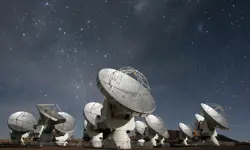
ALMA – the high altitude observatory
The Atacama Large Millimetre/submillimetre Array (ALMA) is the largest and most expensive ground-based telescope built, revolutionising our understanding of stars and planetary systems. Building it in the Atacama Desert in Chile required the ingenuity of hundreds of engineers.

Communicating with outer space
The Royal Academy of Engineering awarded a team at BAE Systems the Major Project Award in June 2016 for their development of a powerful satellite modem system, pivotal in enabling the precise control of the pioneering Rosetta spacecraft and the first-ever soft landing of a spacecraft on a comet.
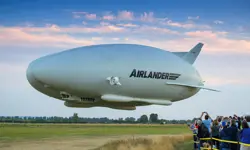
An aircraft like no other
The Airlander made headlines when it embarked on its first test flight in August 2016 as the world’s largest aircraft. Chris Daniels at Hybrid Air Vehicles Limited, and David Burns, Airlander’s Chief Test Pilot, talk about the engineering that helped it reach this stage and plans for the craft’s future.

Q&A: Lucy Harden
Lucy Harden is a mechanical engineer on BAE Systems’ Digital Light Engine Head-Up Display development programme. She devises innovative solutions for pilots to display essential flight information that sits directly in their line of sight and is overlaid onto the real world.
Other content from Ingenia
Quick read

- Environment & sustainability
- Opinion
A young engineer’s perspective on the good, the bad and the ugly of COP27

- Environment & sustainability
- Issue 95
How do we pay for net zero technologies?
Quick read

- Transport
- Mechanical
- How I got here
Electrifying trains and STEMAZING outreach

- Civil & structural
- Environment & sustainability
- Issue 95